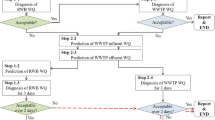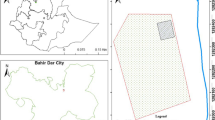Abstract
In numerous wastewater treatment processes, the parameters of biological oxygen demand (BOD), chemical oxygen demand (COD), and total suspended solids (TSS) assume a pivotal role. Typically, conventional statistical methods are employed for the surveillance of these three variables. However, in many real-world scenarios, data collection may occur under uncertain conditions, and not all measurements in the dataset are characterized by precision. This research endeavor aims to oversee these critical variables by constructing Hotelling’s \({T}^{2}\) control chart using neutrosophic data. The proposed approach utilizes neutrosophic observations of the three variables to create the neutrosophic Hotelling’s \({T}^{2}\) (NHT) control chart. Additionally, a comparative analysis has been conducted using the Sullivan and Woodall (SW) method and the Holmes and Mergen (HM) method to assess the effectiveness of each of these methods in detecting shifts and establishing forthcoming production limits. Notably, the SW method exhibits higher sensitivity in shift detection when compared to the HM method. The SW method has been found better for identifying the early shift than that of HM. The mean vector has been computed along with the covariance matrix estimates using both the SW and HM methods to estimate the future production limits. Finally, a MYT-decomposition approach has been employed to identify the sources of variability for each of the three variables.
Access this article
We’re sorry, something doesn't seem to be working properly.
Please try refreshing the page. If that doesn't work, please contact support so we can address the problem.








Similar content being viewed by others
Data Availability
The data are given in the paper.
References
Aslam, M., & Arif, O. H. (2020). Multivariate analysis under indeterminacy: An application to chemical content data. Journal of Analytical Methods in Chemistry, 2020. Article ID 1406028:6. https://doi.org/10.1155/2020/1406028
Bhattacharjee, S., Alattas, K. A., El-Sousy, F. F., Mohammadzadeh, A., Asad, J. H., Mobayen, S., & Alshaikh, N. (2022). A type-2 fuzzy logic approach for forecasting of effluent quality parameters of wastewater treatment. Mathematical Problems in Engineering, 2022(3), 1–10. https://doi.org/10.1155/2022/1965157
Chen, J., Ye, J., & Du, S. (2017a). Scale effect and anisotropy analyzed for neutrosophic numbers of rock joint roughness coefficient based on neutrosophic statistics. Symmetry, 9(10), 208.
Chen, J., Ye, J., Du, S., & Yong, R. (2017b). Expressions of rock joint roughness coefficient using neutrosophic interval statistical numbers. Symmetry, 9(7), 123.
García-Bustos, S., León, J., & Pastuizaca, M. N. (2020). Hotelling T2 chart using the generalized multiple dependent state sampling scheme. International Journal of Quality & Reliability Management, 38(6), 1265–1277.
Gonzalez-de la Parra, M., & Rodriguez-Loaiza, P. J. Q. E. (2003). Application of the multivariate T2 control chart and the Mason–Tracy–Young decomposition procedure to the study of the consistency of impurity profiles of drug substances. Quality Engineering., 16(1), 127–142.
Hotelling, H. (1947). Multivariate quality control-illustrated by the air testing of sample bombsights. Techniques of statistical analysis.
Hotelling, H. A. R. O. L. D. (1947). Multivariate quality control. Techniques of statistical analysis. New York: McGraw-Hill.
Johnson, R. A., & Wichern, D. W. (2002). Applied multivariate statistical analysis (Vol. 5): Prentice hall Upper Saddle River, NJ.
Kashif, M., Nida, H., Khan, M. I., & Aslam, M. (2019). Decomposition of matrix under neutrosophic environment. Infinite Study. https://doi.org/10.5281/zenodo.3569677
Kashif, M., Khan, M. I., Ullah, S., & Aslam, M. (2023). Neutrosophic linear models for bioinformatics Cognitive intelligence with neutrosophic statistics in bioinformatics (pp. 71–85). Elsevier. https://doi.org/10.1016/B978-0-323-99456-9.00005-2
Mason, R. L., Tracy, N. D., & Young, J. C. (1995). Decomposition of T 2 for multivariate control chart interpretation. Journal of Equality Technology, 27(2), 99–108.
Nida, H., Kashif, M., Khan, M. I., Ahmad, L., & Aslam, M. (2023). Design of Hotelling T2 control chart using various covariance structures. Communications in statistics-theory and methods, 1–12. https://doi.org/10.1080/03610926.2023.2234520
Nugraha, J., Fatimah, I., & Prabowo, R. G. (2017). Control of wastewater using multivariate control chart. Paper presented at the AIP Conference Proceedings. AIP Conference Proceedings, Volume 1823, Issue 1, id.020126. https://doi.org/10.1063/1.4978199
Prins, J., & Mader, D. J. Q. E. (1997). Multivariate Control Charts for Grouped and Individual Observations. Quality Engineering, 10(1), 49–57.
Santos-Fernández, E. (2012). Multivariate statistical quality control using R (Vol. 14): Springer Science & Business Media. https://doi.org/10.1007/978-1-4614-5453-3
Saritha, M., & Varadharajan, R. (2023). Multivariate Hotelling-T 2 control chart for neutrosophic data. Mathematics and Statistics, 11(2), 288–293. https://doi.org/10.13189/ms.2023.110206
Smarandache, F. (2010). Multispace & multistructure. Neutrosophic transdisciplinarity (100 Collected Papers of Science) (Vol. 4): Infinite Study.
Smarandache, F. (2014). Introduction to Neutrosophic statistics, sitech and education Publisher (p. 123). Romania-Educational Publisher, Columbus, Ohio, USA.
Smarandache, F. (2022). Neutrosophic statistics is an extension of interval statistics, while plithogenic statistics is the most general form of statistics (second version): Infinite Study.
Tracy, N. D., Young, J. C., & Mason, R. L. (1992). Multivariate control charts for individual observations. Journal of Quality Technology, 24(2), 88–95.
Ullah, S., Kashif, M., Aslam, M., Haider, G., AlAita, A., & Saleem, M. (2023). A generalized approach to compute neutrosophic k-factor analysis of variance. Journal of Intelligent & Fuzzy Systems(Preprint), 45(4), 6005–6017.
Vanhatalo, E., Kulahci, M. J. Q., International R. E. (2015). The effect of autocorrelation on the Hotelling T2 control chart. Quality and Reliability Engineering International., 31(8), 1779–1796.
Vargas, N. J. A. J. J. (2003). Robust estimation in multivariate control charts for individual observations. Journal of Quality Technology, 35(4), 367–376.
Wibawati, W., Ahsan, M., Khusna, H., Qori’atunnadyah, M., & Udiatami, W. M. (2022). Multivariate control chart based on neutrosophic hotelling T2 statistics and its application. JTAM (jurnal Teori Dan Aplikasi Matematika), 6(1), 85–92.
Wibawati, W., Ahsan, M., & Khusna, H. (2023). Neutrosophic multivariate EWMA control chart. Decision Science Letters, 12(4), 807–816.
Acknowledgements
The authors are deeply thankful to the editor and reviewers for their valuable suggestions to improve the quality and presentation of the paper.
Author information
Authors and Affiliations
Contributions
M.K and M.A analyze the data and format the paper, whereas AM and MIK helped to write up the paper and improve the grammar of the paper.
Corresponding author
Ethics declarations
Conflict of Interest
The authors declare no competing interests.
Additional information
Publisher's Note
Springer Nature remains neutral with regard to jurisdictional claims in published maps and institutional affiliations.
Rights and permissions
Springer Nature or its licensor (e.g. a society or other partner) holds exclusive rights to this article under a publishing agreement with the author(s) or other rightsholder(s); author self-archiving of the accepted manuscript version of this article is solely governed by the terms of such publishing agreement and applicable law.
About this article
Cite this article
Kashif, M., Almarashi, A.M., Aslam, M. et al. Water Waste Monitoring Using Neutrosophic Multivariate T2 Control Chart. Water Air Soil Pollut 234, 747 (2023). https://doi.org/10.1007/s11270-023-06768-w
Received:
Accepted:
Published:
DOI: https://doi.org/10.1007/s11270-023-06768-w




